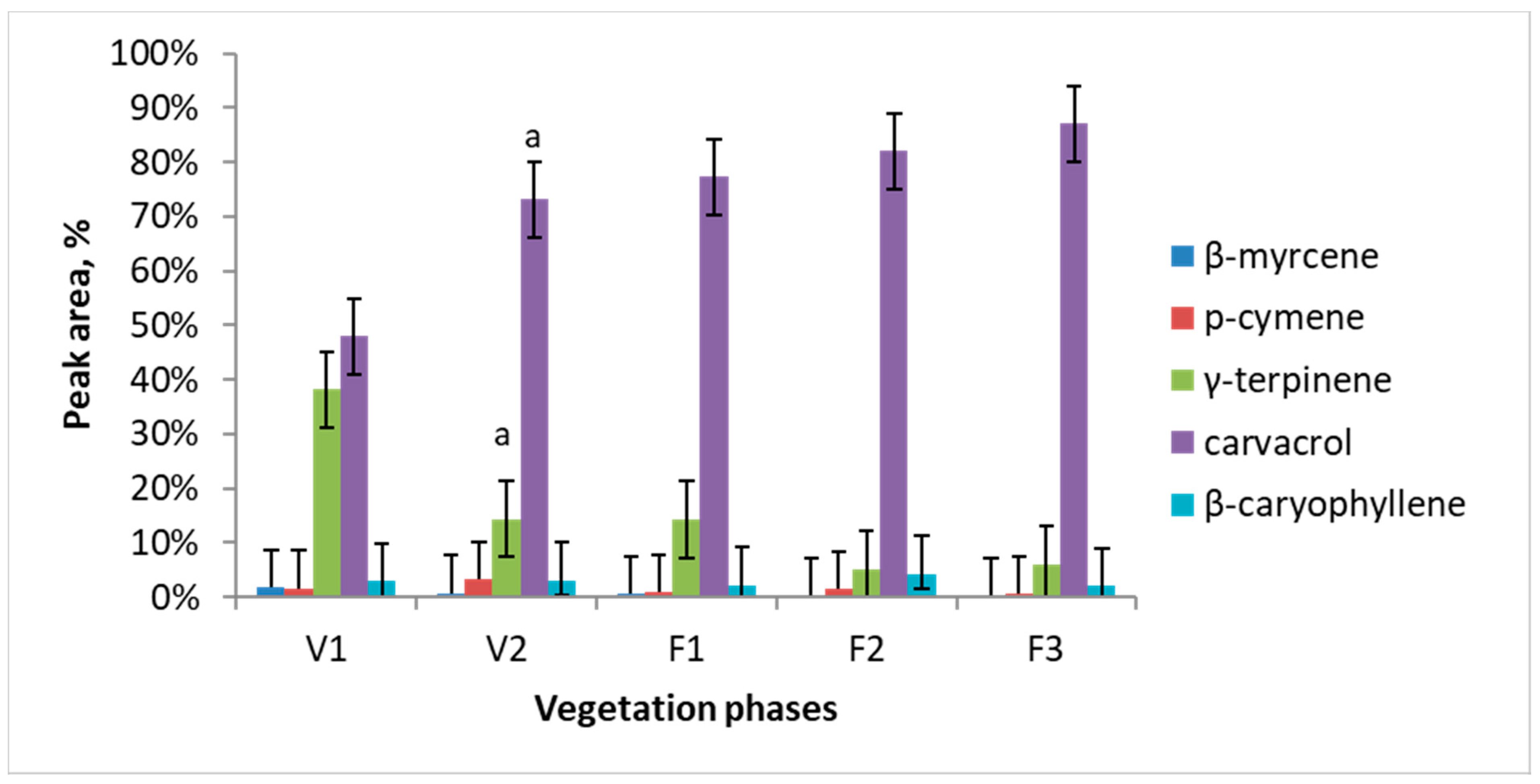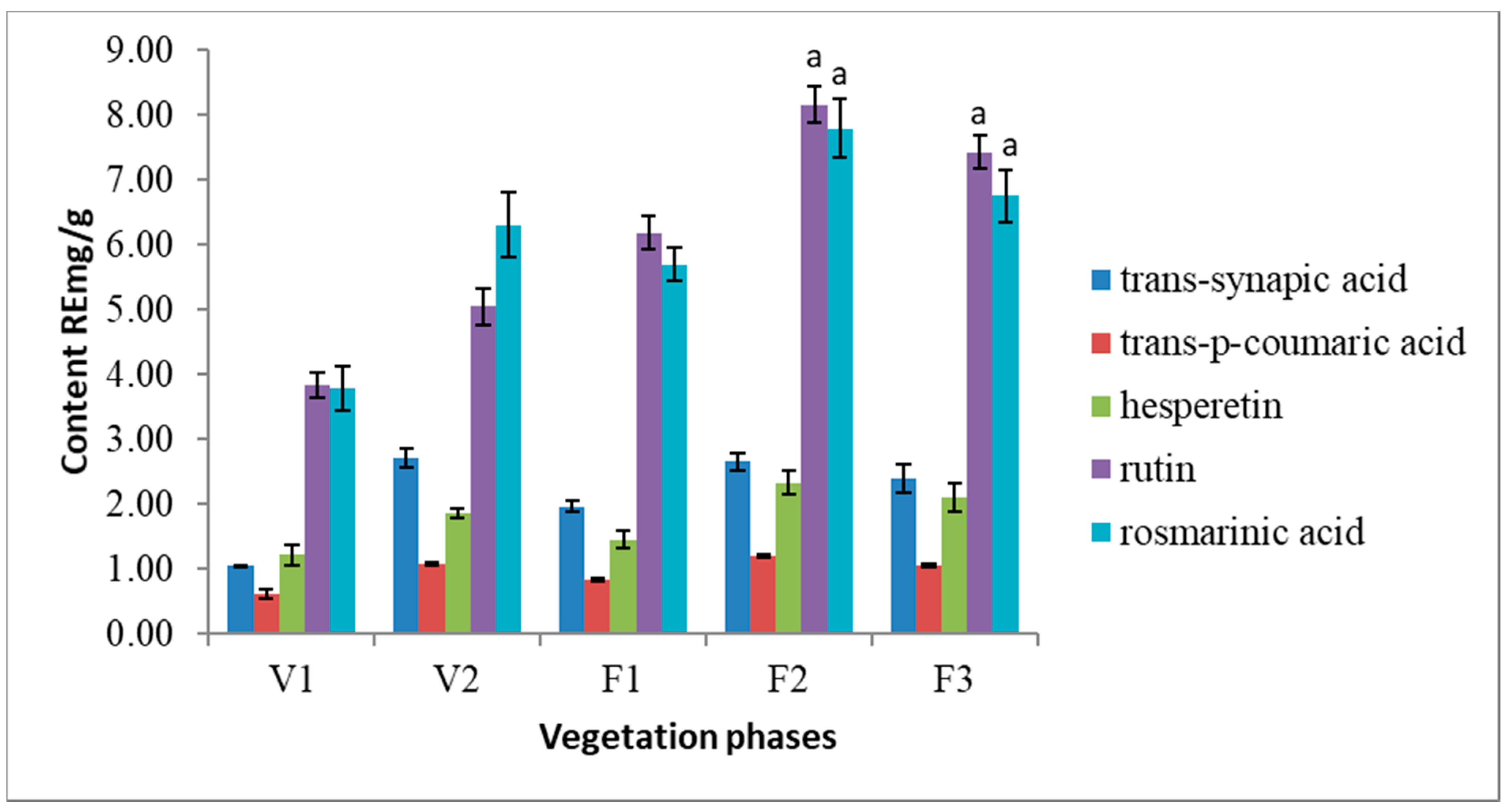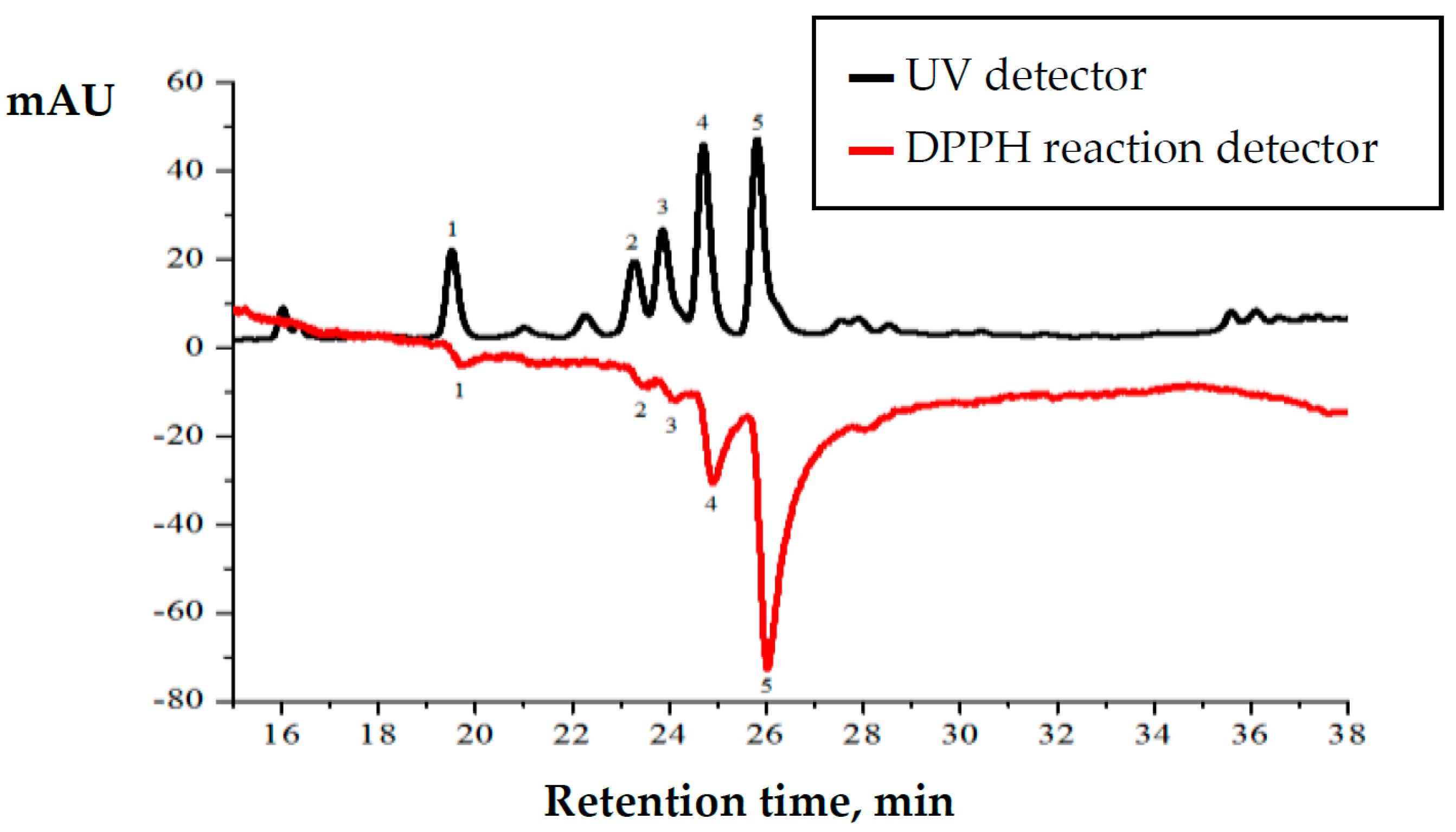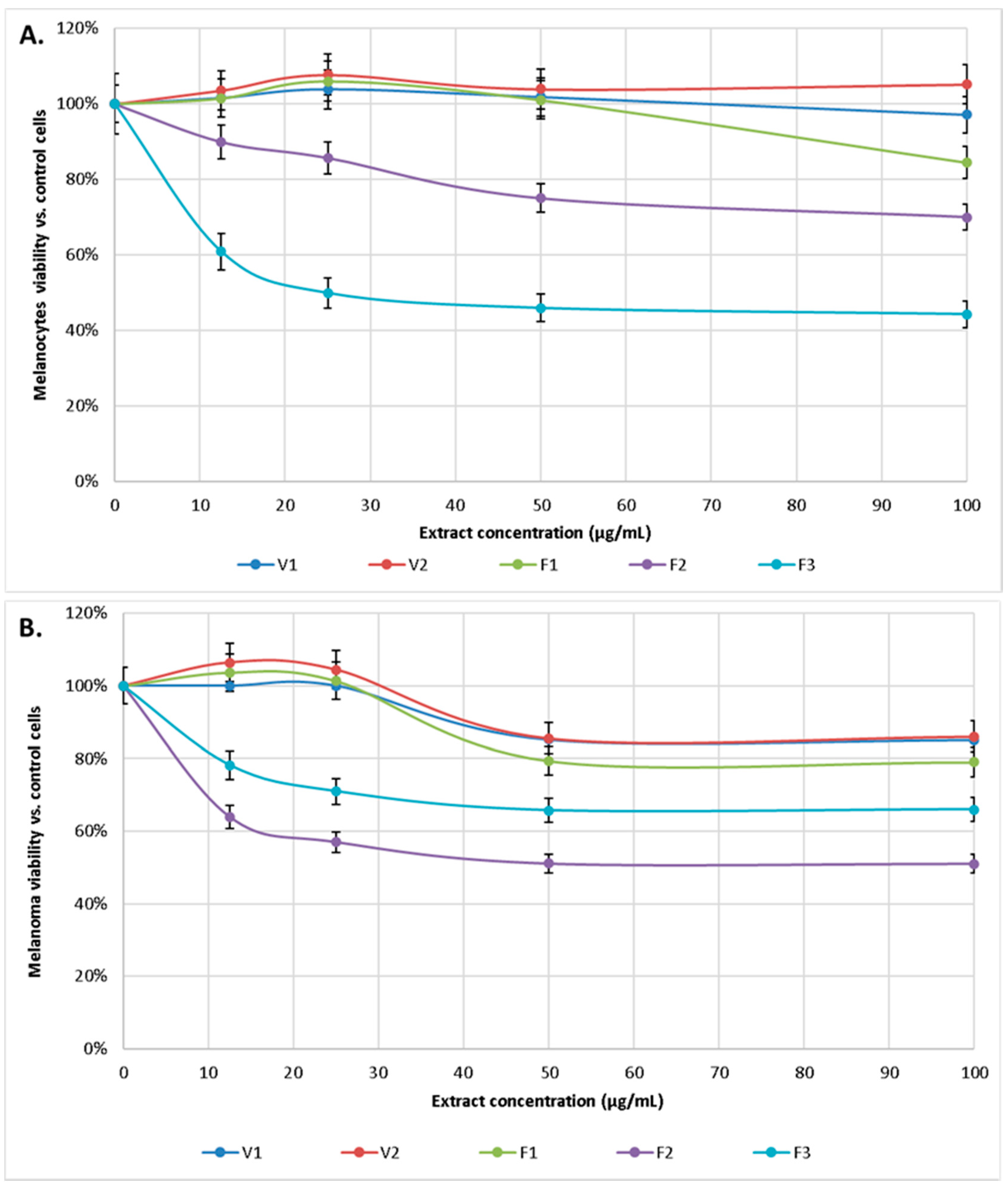Evaluation of Chemical Composition, Radical Scavenging and Antitumor Activities of Satureja hortensis L. Herb Extracts
Abstract
:1. Introduction
2. Materials and Methods
2.1. Chemicals
2.2. Raw Material
2.3. Extraction Using Organic Solvents
2.4. Volatile Compounds Determination by GCMS
2.5. Phenolic Compounds Determination
2.6. Radical Scavenging Activity Measurement
2.7. Biological Effects of S. hortensis L.
2.8. S. hortensis L. Effect on Cells Viability
2.9. Effect of S. hortensis L. on Lipid Peroxidation
2.10. Statistical Data Analysis
3. Results
4. Discussion
5. Conclusions
Author Contributions
Funding
Institutional Review Board Statement
Informed Consent Statement
Data Availability Statement
Acknowledgments
Conflicts of Interest
References
- Ayad, G.W. The CGIAR and the Convention on Biological Diversity Widening Perspectives on Biodiversity; IUNC: Glanda, Switzerland; International Academy of the Enviroment: Geneva, Switzerland, 1994. [Google Scholar]
- Global Strategy for Plant Conservation. Adopted by the Convention on Biological Diversity; CBD Secretariat: Montreal, QC, Canada, 2002; Volume VI. [Google Scholar]
- Omidbeygi, M.; Barzegar, M.; Hamidi, Z.; Naghdibadi, H. Antifungal activity of thyme, summer savory and clove essential oils against Aspergillus Xavus in liquid medium and tomato paste. Food Control 2007, 18, 1518–1523. [Google Scholar] [CrossRef]
- Exarchou, V.; Nenadis, N.; Tsimidou, M.Z.; Gerothanassis, I.P.; Troganis, A.; Boskou, D. Antioxidant Activities and Phenolic Composition of Extracts from Greek Oregano, Greek Sage, and Summer Savory. J. Agric. Food Chem. 2002, 50, 5294–5299. [Google Scholar] [CrossRef] [PubMed]
- Pirbalouti, A.G.; Rahimmalek, M.; Elikaei-Nejhada, L.; Hamedia, B. Essential oil compositions of summer savory under foliar application of jasmonic acid and salicylic acid. J. Essent. Oil Res. 2004, 26, 342–347. [Google Scholar] [CrossRef]
- Omidbaigi, R.; Hejazi, M. Essential oil content and compositions of Satureja hortensis of two different origins. J. Essent. Oil Bear. Plants 2004, 7, 175–178. [Google Scholar] [CrossRef]
- Mozuriene, E.; Bartkiene, E.; Juodeikiene, G.; Zadeike, D.; Basinskiene, L.; Maruska, A.; Stankevicius, M.; Ragazinskiene, O.; Damasius, J.; Cizeikiene, D. The effect of savoury plants, fermented with lactic acid bacteria, on the microbiological contamina-tion, quality, and acceptability of unripened curd cheese. LWT Food Sci. Technol. 2016, 69, 161–168. [Google Scholar] [CrossRef]
- Ragažinskienė, O. Evaluation of medicinal plants investigation at Kaunas botanical garden of Vytautas Magnus univer-sity for the development of herbal drugs industry in Lithuania. In Papers of the Botanical Garden of Vytautas Magnus University; Vytautas Magnus University: Kaunas, Lithuania, 2009; Volume 13, pp. 44–55. [Google Scholar]
- Ragažinskienė, O.; Maruška, A. Evaluation of phytochemical composition of perspective medicinal plants at Vytautas Magnus University. In Papers of the Botanical Garden of Vytautas Magnus University; Vytautas Magnus University: Kaunas, Lithuania, 2011; Volume 15, pp. 82–94. [Google Scholar]
- Bandonienė, D.; Gruzdienė, D.; Venskutonis, P.R.; Murkovic, M. Antioxidant activity of sage (Salvia officinalis L.), savory (Satureja hortensis L.) and borage (Borago officinalis L.) extracts in rapeseed oil. Eur. J. Lipid Sci. Technol. 2002, 104, 286–292. [Google Scholar] [CrossRef]
- Kemertelidze, E.P.; Sagareishvili, T.G.; Syrov, V.N.; Khushbaktova, Z.A. Chemical Composition and Pharmacological Activity of Garden Savory (Satureja hortensis L.) Occurring in Georgia. Pharm. Chem. J. 2004, 38, 319–322. [Google Scholar] [CrossRef]
- Kemetelidze, E.; Alania, M.; Sagareishvili, T.; Shalashvili, K.; Kavtaradze, N. Medicinal preparations on the basis of vegeta-ble phenolic compounds. Planta Med. 2009, 10, PD62. [Google Scholar] [CrossRef]
- Momtaz, S.; Abdollah, M. An update on pharmacology of Satureja species; from antioxidant, antimicrobial, antidiabetes and anti-hyperlipidemic to reproductive stimulation. Int. J. Pharmacol. 2010, 6, 454–461. [Google Scholar] [CrossRef]
- Hajimehdipoor, H.; Saeidnia, S.; Gohari, A.R.; Hamedani, M.P.; Shekarchi, M. Comparative study of rosmarinic acid content in some plants of Labiatae family. Pharm. Mag. 2012, 8, 37–41. [Google Scholar] [CrossRef] [Green Version]
- Zhang, L.; Ravipati, A.S.; Koyyalamudi, S.R.; Jeong, S.C.; Reddy, N.; Smith, P.T.; Wu, M.J. Antioxidant and an-ti-inflammatory activities of selected medicinal plants containing phenolic and flavonoid compounds. J. Agric. Food Chem. 2011, 59, 12361–12367. [Google Scholar] [CrossRef] [PubMed]
- Chkhikvishvili, I.; Sanikidze, T.; Gogia, N.; Mchedlishvili, T.; Enukidze, M.; Machavariani, M.; Vinokur, Y.; Rodov, V. Rosma-rinic acid—Rich extracts of summer savory (Satureja hortensis L.) protect jurkat T cells against oxidative stress. Oxid. Med. Cell. Longev. 2013, 2013, 456253. [Google Scholar] [CrossRef] [PubMed] [Green Version]
- Güllüce, M.; Sökmen, M.; Daferera, D.; Aǧar, G.; Özkan, H.; Kartal, N.; Polissiou, M.; Sökmen, A.; Şahin, F. In Vitro Antibacterial, Antifungal, and Antioxidant Activities of the Essential Oil and Methanol Extracts of Herbal Parts and Callus Cultures of Satureja hortensis L. J. Agric. Food Chem. 2003, 51, 3958–3965. [Google Scholar] [CrossRef] [PubMed]
- Davitaia, G.; Mchedlishvili, D.; Kuchukashvili, Z.; Tabatadze, T. Influence of flavonoids isolated from Satureja hortensis L. on hypercholesterolemic rabbits. Indian J. Pharm. 2005, 37, 259. [Google Scholar] [CrossRef] [Green Version]
- Mihajilov-Krstev, T.; Radnovic, D.; Kitić, D.; Stojanovic-Radic, Z.; Zlatkovic, B. Antimicrobial activity of Satureja hortensis L. essential oil against pathogenic microbial strains. Arch. Biol. Sci. 2010, 62, 159–166. [Google Scholar] [CrossRef]
- Rezvanpanah, S.; Rezaei, K.; Golmakani, M.; Razavi, S. Antibacterial properties and chemical characterization of the essen-tial oils from summer savory extracted by microwave-assisted hydrodistillation. Braz. J. Microbiol. 2011, 42, 1453–1462. [Google Scholar] [CrossRef] [Green Version]
- Sabzghabaee, A.M.; Davoodi, N.; Ebadian, B.; Aslani, A.; Ghannadi, A. Clinical evaluation of the essential oil of “Satureja hortensis L.” for the treatment of denture stomatitis. Dent. Res. J. 2012, 9, 198–202. [Google Scholar]
- Stutte, G.W. Process and product: Recirculation hydroponics andbioactive compounds in a controlled environment. HortScience 2006, 41, 526–530. [Google Scholar] [CrossRef]
- Montero, A.J.; Jassem, J. Cellular Redox Pathways as a Therapeutic Target in the Treatment of Cancer. Drugs 2011, 71, 1385–1396. [Google Scholar] [CrossRef]
- Bickers, D.R.; Athar, M. Oxidative Stress in the Pathogenesis of Skin Disease. J. Investig. Derm. 2006, 126, 2565–2575. [Google Scholar] [CrossRef] [Green Version]
- Farmer, E.E.; Mueller, M.J. ROS-mediated lipid peroxidation and RES-activated signaling. Annu. Rev. Plant Biol. 2013, 64, 429–450. [Google Scholar] [CrossRef] [PubMed]
- Briganti, S.; Picardo, M. Antioxidant activity, lipid peroxidation and skin diseases. What’s new. J. Eur. Acad. Dermatol. Venereol. 2003, 17, 663–669. [Google Scholar] [CrossRef] [PubMed]
- Di Meo, F.; Lemaur, V.; Cornil, J.; Lazzaroni, R.; Duroux, J.-L.; Olivier, Y.; Trouillas, P. Free Radical Scavenging by Natural Polyphenols: Atom versus Electron Transfer. J. Phys. Chem. A 2013, 117, 2082–2092. [Google Scholar] [CrossRef] [PubMed]
- Gęgotek, A.; Rybałtowska-Kawałko, P.; Skrzydlewska, E. Rutin as a mediator of lipid metabolism and cellular sig-naling pathways interactions in fibroblasts altered by UVA and UVB radiation. Oxidative Med. Cell. Longev. 2017, 2017. [Google Scholar] [CrossRef] [PubMed]
- Rimovas, A.; Akuneca, I.; Stankecičius, M.; Kornyšova, O.; Ragažinskienė, O. Variation of total amount of phenolic and vola-tile compounds of Satureja hortensis L. and Satureja montana L. extracts during different vegetacion periods. In Proceedings of the 7th International Scientific Conference the Vital Nature Sign, Kaunas, Lithuania, 16–19 May 2013. [Google Scholar]
- Ligor, M.; Stankevičius, M.; Wenda-Piesik, A.; Obelevičius, K.; Ragažinskienė, O.; Stanius, Ž.; Maruška, A.; Buszewski, B. Com-parative gas chromatographic–mass spectrometric evaluation of hop (Humulus lupulus L.) essential oils and extracts obtained using different sample preparation methods. Food Anal. Methods 2014, 7, 1433–1442. [Google Scholar] [CrossRef] [Green Version]
- Stankevičius, M.; Akuņeca, I.; Jãkobsone, I.; Maruška, A. Analysis of phenolic compounds and radical scavenging activities of spice plants extracts. Food Chem. Technol. 2010, 44, 85–91. [Google Scholar]
- Fotakis, G.; Timbrell, J.A. In vitro cytotoxicity assays: Comparison of LDH, neutral red, MTT and protein assay in hepa-toma cell lines following exposure to cadmium chloride. Toxicol. Lett. 2006, 160, 171–177. [Google Scholar] [CrossRef]
- Luo, X.P.; Yazdanpanah, M.; Bhooi, N.; Lehotay, D.C. Determination of Aldehydes and Other Lipid Peroxidation Products in Biological Samples by Gas Chromatography-Mass Spectrometry. Anal. Biochem. 1995, 228, 294–298. [Google Scholar] [CrossRef]
- Stankevičius, M.; Akuņeca, I.; Jãkobsone, I.; Maruška, A. Comparative analysis of radical scavenging and antioxidant activity of phenolic compounds present in everyday use spice plants by means of spectrophotometric and chromatographic methods. J. Sep. Sci. 2011, 34, 1261–1267. [Google Scholar] [CrossRef]
- Guesmi, F.; Tyagi, A.K.; Prasad, S.; Landoulsi, A. Terpenes from essential oils and hydrolate of Teucrium alopecurus triggered apoptotic events dependent on caspases activation and PARP cleavage in human colon cancer cells through de-creased protein expressions. Oncotarget 2018, 9, 32305. [Google Scholar] [CrossRef] [Green Version]
- Rolim, P.M.; Fidelis, G.P.; Padilha, C.E.A.; Santos, E.S.; Rocha, H.A.O.; Macedo, G.R. Phenolic profile and antiox-idant activity from peels and seeds of melon (Cucumis melo L. var. reticulatus) and their antiproliferative effect in cancer cells. Braz. J. Med. Biol. Res. 2018, 51, e6069. [Google Scholar] [CrossRef] [PubMed] [Green Version]
- Nichols, J.A.; Katiyar, S.K. Skin photoprotection by natural polyphenols: Anti-inflammatory, antioxidant and DNA repair mechanisms. Arch. Derm. Res. 2009, 302, 71–83. [Google Scholar] [CrossRef] [PubMed] [Green Version]
- Al-Marzoqi, A.H.; Hussein, H.J.; Al-Khafaji, N.M.S. Antibacterial activity of the crude phenolic, alkaloid and ter-penoid compounds extracts of Lactuca serriola L. on human pathogenic bacteria. Chem. Mater. Res. 2015, 7, 8–10. [Google Scholar]
- Hajhashemi, V.; Zolfaghari, B.; Yousefi, A. Antinociceptive and anti-inflammatory activities of Satureja hortensis seed es-sential oil, hydroalcoholic and polyphenolic extracts in animal models. Med. Princ. Pract. 2012, 21, 178–182. [Google Scholar] [CrossRef]
- Baser, K.H.C.; Ozec, T.; Kirimer, N.; Tumen, G. Comperative study of the essential oils of wild and cultivated Satureja hortensis L. J. Essent. Oil Res. 2004, 6, 422–424. [Google Scholar] [CrossRef]
- Khan, I.; Bahuguna, A.; Kumar, P.; Bajpai, V.K.; Kang, S.C. In vitro and in vivo antitumor potential of carvacrol nanoemulsion against human lung adenocarcinoma A549 cells via mitochondrial mediated apoptosis. Sci. Rep. 2018, 8, 144. [Google Scholar] [CrossRef] [Green Version]
- Arunasree, K.M. Anti-proliferative effects of carvacrol on a human metastatic breast cancer cell line, MDA-MB 231. Phytomedicine 2010, 17, 581–588. [Google Scholar] [CrossRef]
- Stratil, P.; Klejdus, B.; Kubáň, V. Determination of phenolic compounds and their antioxidant activity in fruits and cereals. Talanta 2007, 71, 1741–1751. [Google Scholar] [CrossRef]
- Lin, D.; Xing, B. Adsorption of Phenolic Compounds by Carbon Nanotubes: Role of Aromaticity and Substitution of Hydroxyl Groups. Environ. Sci. Technol. 2008, 42, 7254–7259. [Google Scholar] [CrossRef]
- Fenercioglu, A.K.; Saler, T.; Genc, E.; Sabuncu, H.; Altuntas, Y. The effects of polyphenol-containing antioxidants on oxidative stress and lipid peroxidation in Type 2 diabetes mellitus without complications. J. Endocrinol. Investig. 2009, 33, 118–124. [Google Scholar] [CrossRef]
- Zhang, H.; Tsao, R. Dietary polyphenols, oxidative stress and antioxidant and anti-inflammatory effects. Curr. Opin. Food Sci. 2016, 8, 33–42. [Google Scholar] [CrossRef]
- Lohan, S.B.; Müller, R.; Albrecht, S.; Mink, K.; Tscherch, K.; Ismaeel, F.; Meinke, M.C. Free radicals induced by sun-light in different spectral regions–in vivo versus ex vivo study. Exp. Dermatol. 2016, 25, 380–385. [Google Scholar] [CrossRef] [PubMed]
- Yin, H.; Xu, L.; Porter, N.A. Free Radical Lipid Peroxidation: Mechanisms and Analysis. Chem. Rev. 2011, 111, 5944–5972. [Google Scholar] [CrossRef] [PubMed]
- Rouzer, C.A.; Marnett, L.J. Endocannabinoid Oxygenation by Cyclooxygenases, Lipoxygenases, and Cytochromes P450: Cross-Talk between the Eicosanoid and Endocannabinoid Signaling Pathways. Chem. Rev. 2011, 111, 5899–5921. [Google Scholar] [CrossRef] [PubMed]
- Sen, T.; Sen, N.; Tripathi, G.; Chatterjee, U.; Chakrabarti, S. Lipid peroxidation associated cardiolipin loss and mem-brane depolarization in rat brain mitochondria. Neurochem. Int. 2006, 49, 20–27. [Google Scholar] [CrossRef] [PubMed]
- Wheeler, H. Disease Alterations in Permeability and Membranes. How Plants Suff. Dis. 1978, 2, 327–347. [Google Scholar] [CrossRef]
- Gęgotek, A.; Skrzydlewska, E. Biological effect of protein modifications by lipid peroxidation products. Chem. Phys. Lipids 2019, 221, 46–52. [Google Scholar] [CrossRef]
- Hassan, W.; Gul, S.; Rehman, S.; Noreen, H.; Shah, Z.; Mohammadzai, I.; Zaman, B. Chemical composition, essential oil characterization and antimicrobial activity of Carum copticum. Vitam Min. 2016, 5, 100139. [Google Scholar] [CrossRef]
- Gęgotek, A.; Domingues, P.; Skrzydlewska, E. Proteins involved in the antioxidant and inflammatory response in rutin-treated human skin fibroblasts exposed to UVA or UVB irradiation. J. Derm. Sci. 2018, 90, 241–252. [Google Scholar] [CrossRef] [Green Version]
- Witkamp, R.F. Fatty acids, endocannabinoids and inflammation. Eur. J. Pharm. 2016, 785, 96–107. [Google Scholar] [CrossRef]
- Perk, A.A.; Shatynska-Mytsyk, I.; Gerçek, Y.C.; Boztas, K.; Yazgan, M.; Fayyaz, S.; Farooqi, A.A. Rutin mediated targeting of signaling machinery in cancer cells. Cancer Cell Int. 2014, 14, 124. [Google Scholar] [CrossRef] [PubMed] [Green Version]
- Iriti, M.; Kubina, R.; Cochis, A.; Sorrentino, R.; Varoni, E.; Kabała-Dzik, A.; Azzimonti, B.; Dziedzic, A.; Rimondini, L.; Wojtyczka, R.D. Rutin, a Quercetin Glycoside, Restores Chemosensitivity in Human Breast Cancer Cells. Phytother. Res. 2017, 31, 1529–1538. [Google Scholar] [CrossRef] [PubMed]
- Ben Sghaier, M.; Pagano, A.; Mousslim, M.; Ammari, Y.; Kovacic, H.; Luis, J. Rutin inhibits proliferation, attenuates superoxide production and decreases adhesion and migration of human cancerous cells. Biomed. Pharm. 2016, 84, 1972–1978. [Google Scholar] [CrossRef] [PubMed]
- Eftekhar, N.; Moghimi, A.; Boskabady, M.H. The Effects of Ocimum basilicum Extract and Its Constituent, Rosmarinic Acid on Total and Differential Blood WBC, Serum Levels of NO, MDA, Thiol, SOD, and CAT in Ovalbumin Sensitized Rats. Iran. J. Pharm. Res. IJPR 2018, 17, 1371–1385. [Google Scholar] [PubMed]
- Tavafi, M.; Ahmadvand, H. Effect of rosmarinic acid on inhibition of gentamicin induced nephrotoxicity in rats. Tissue Cell 2011, 43, 392–397. [Google Scholar] [CrossRef]
- Fadel, O.; El Kirat, K.; Morandat, S. The natural antioxidant rosmarinic acid spontaneously penetrates membranes to inhibit lipid peroxidation in situ. Biochim. Biophys. Acta (BBA) Biomembr. 2011, 1808, 2973–2980. [Google Scholar] [CrossRef] [Green Version]
- Yesil-Celiktas, O.; Sevimli, C.; Bedir, E.; Vardar-Sukan, F. Inhibitory Effects of Rosemary Extracts, Carnosic Acid and Rosmarinic Acid on the Growth of Various Human Cancer Cell Lines. Plant Foods Hum. Nutr. 2010, 65, 158–163. [Google Scholar] [CrossRef]






Publisher’s Note: MDPI stays neutral with regard to jurisdictional claims in published maps and institutional affiliations. |
© 2021 by the authors. Licensee MDPI, Basel, Switzerland. This article is an open access article distributed under the terms and conditions of the Creative Commons Attribution (CC BY) license (http://creativecommons.org/licenses/by/4.0/).
Share and Cite
Bimbiraitė-Survilienė, K.; Stankevičius, M.; Šuštauskaitė, S.; Gęgotek, A.; Maruška, A.; Skrzydlewska, E.; Barsteigienė, Z.; Akuņeca, I.; Ragažinskienė, O.; Lukošius, A. Evaluation of Chemical Composition, Radical Scavenging and Antitumor Activities of Satureja hortensis L. Herb Extracts. Antioxidants 2021, 10, 53. https://doi.org/10.3390/antiox10010053
Bimbiraitė-Survilienė K, Stankevičius M, Šuštauskaitė S, Gęgotek A, Maruška A, Skrzydlewska E, Barsteigienė Z, Akuņeca I, Ragažinskienė O, Lukošius A. Evaluation of Chemical Composition, Radical Scavenging and Antitumor Activities of Satureja hortensis L. Herb Extracts. Antioxidants. 2021; 10(1):53. https://doi.org/10.3390/antiox10010053
Chicago/Turabian StyleBimbiraitė-Survilienė, Kristina, Mantas Stankevičius, Simona Šuštauskaitė, Agnieszka Gęgotek, Audrius Maruška, Elżbieta Skrzydlewska, Zita Barsteigienė, Ieva Akuņeca, Ona Ragažinskienė, and Audronis Lukošius. 2021. "Evaluation of Chemical Composition, Radical Scavenging and Antitumor Activities of Satureja hortensis L. Herb Extracts" Antioxidants 10, no. 1: 53. https://doi.org/10.3390/antiox10010053
APA StyleBimbiraitė-Survilienė, K., Stankevičius, M., Šuštauskaitė, S., Gęgotek, A., Maruška, A., Skrzydlewska, E., Barsteigienė, Z., Akuņeca, I., Ragažinskienė, O., & Lukošius, A. (2021). Evaluation of Chemical Composition, Radical Scavenging and Antitumor Activities of Satureja hortensis L. Herb Extracts. Antioxidants, 10(1), 53. https://doi.org/10.3390/antiox10010053






